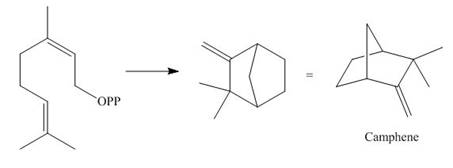
ORGANIC CHEM W/BIOLOGICAL TOP. ACCESS
6th Edition
ISBN: 9781264382545
Author: SMITH
Publisher: MCG CUSTOM
expand_more
expand_more
format_list_bulleted
Concept explainers
Textbook Question
Chapter 29, Problem 42P
Draw a stepwise mechanism for the following conversion, which forms camphene. Camphene is a component of camphor and citronella oils.

Expert Solution & Answer
Want to see the full answer?
Check out a sample textbook solution
Students have asked these similar questions
Problem 5-48
Assign R or S configurations to the chirality centers in ascorbic acid (vitamin C).
OH
H
OH
HO
CH2OH Ascorbic acid
O H
Problem 5-49
Assign R or S stereochemistry to the chirality centers in the following Newman projections:
H
Cl
H
CH3
H3C.
OH
H3C
(a)
H
H
H3C
(b)
CH3
H
Problem 5-52
Draw the meso form of each of the following molecules, and indicate the plane of symmetry in each:
OH
OH
(a)
CH3CHCH2CH2CHCH3
CH3
H3C.
-OH
(c) H3C
CH3
(b)
Problem 5-66
Assign R or S configurations to the chiral centers in cephalexin, trade-named Keflex, the most widely prescribed
antibiotic in the United States.
H2N H
IHH
S
Cephalexin
N.
CH3
CO₂H
Steps and explanationn please.
Steps and explanationn please.
Chapter 29 Solutions
ORGANIC CHEM W/BIOLOGICAL TOP. ACCESS
Ch. 29.2 - Problem 31.1
One component of jojoba oil is a wax...Ch. 29.3 - Problem 31.2
How would you expect the melting...Ch. 29.3 - Problem 31.3
Draw the products formed when...Ch. 29.3 - Problem 31.4
The main fatty acid component of the...Ch. 29.3 - Prob. 5PCh. 29.7 - Problem 31.10
Locate the isoprene units in each...Ch. 29.7 - Problem 31.11
Locate the isoprene units in...Ch. 29.7 - Problem 31.12
Write a stepwise mechanism for the...Ch. 29.7 - Prob. 14PCh. 29.8 - Prob. 15P
Ch. 29.8 - Prob. 16PCh. 29.8 - Prob. 17PCh. 29 - 31.17 Locate the isoprene units in each...Ch. 29 - Prob. 25PCh. 29 - Locate the isoprene units in each compound. a. e....Ch. 29 - 31.27 Classify each terpene and terpenoid in...Ch. 29 - Prob. 33PCh. 29 - Draw three-dimensional structures f or each...Ch. 29 - Prob. 37PCh. 29 - Prob. 38PCh. 29 - Prob. 39PCh. 29 - Prob. 40PCh. 29 - 31.38 Draw the products formed when cholesterol is...Ch. 29 - 31.39 Draw a stepwise mechanism for the following...Ch. 29 - 31.40 Draw a stepwise mechanism for the following...Ch. 29 - Prob. 44P
Knowledge Booster
Learn more about
Need a deep-dive on the concept behind this application? Look no further. Learn more about this topic, chemistry and related others by exploring similar questions and additional content below.Similar questions
- PLEASE HELP! URGENT!arrow_forward"Water gas" is an industrial fuel composed of a mixture of carbon monoxide and hydrogen gases. When this fuel is burned, carbon dioxide and water result. From the information given below, write a balanced equation and determine the enthalpy of this reaction: CO(g) + O2(g) → CO₂(g) + 282.8 kJ H2(g) + O2(g) → H₂O(g) + 241.8 kJ MacBook Airarrow_forwardPage of 3 4. Calculate AG for the following reaction at 25°C. Will the reaction occur (be spontaneous)? How do you know? NH3(g) + HCl(g) → NH4Cl(s) AH=-176.0 kJ AS-284.8 J-K-1arrow_forward
- true or false The equilibrium constant for this reaction is 0.20. N2O4(g) ⇔ 2NO2(g) Based on the above, the equilibrium constant for the following reaction is 5. 4NO2(g) ⇔ 2N2O4(g)arrow_forwardtrue or false The equilibrium constant for this reaction is 0.20. N2O4(g) ⇔ 2NO2(g) Based on the above, the equilibrium constant for the following reaction is 0.4. 2N2O4(g) ⇔ 4NO2(g)arrow_forwardtrue or false Using the following equilibrium, if heat is added the equilibrium will shift toward the reactants. N2(g) + 3H2(g) ⇔ 2NH3(g) + heatarrow_forward
arrow_back_ios
SEE MORE QUESTIONS
arrow_forward_ios
Recommended textbooks for you
 Chemistry for Today: General, Organic, and Bioche...ChemistryISBN:9781305960060Author:Spencer L. Seager, Michael R. Slabaugh, Maren S. HansenPublisher:Cengage Learning
Chemistry for Today: General, Organic, and Bioche...ChemistryISBN:9781305960060Author:Spencer L. Seager, Michael R. Slabaugh, Maren S. HansenPublisher:Cengage Learning Organic ChemistryChemistryISBN:9781305580350Author:William H. Brown, Brent L. Iverson, Eric Anslyn, Christopher S. FootePublisher:Cengage Learning
Organic ChemistryChemistryISBN:9781305580350Author:William H. Brown, Brent L. Iverson, Eric Anslyn, Christopher S. FootePublisher:Cengage Learning

Chemistry for Today: General, Organic, and Bioche...
Chemistry
ISBN:9781305960060
Author:Spencer L. Seager, Michael R. Slabaugh, Maren S. Hansen
Publisher:Cengage Learning

Organic Chemistry
Chemistry
ISBN:9781305580350
Author:William H. Brown, Brent L. Iverson, Eric Anslyn, Christopher S. Foote
Publisher:Cengage Learning
Nomenclature: Crash Course Chemistry #44; Author: CrashCourse;https://www.youtube.com/watch?v=U7wavimfNFE;License: Standard YouTube License, CC-BY